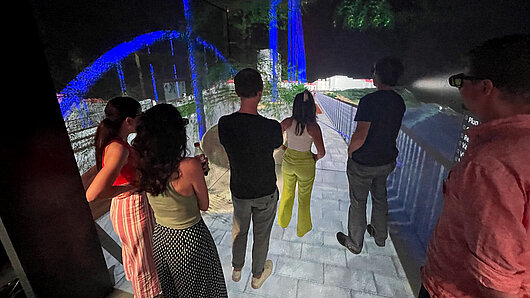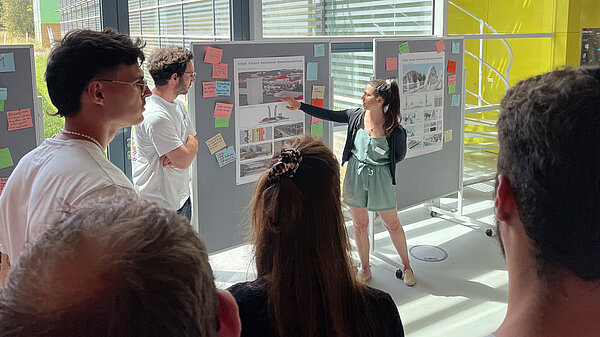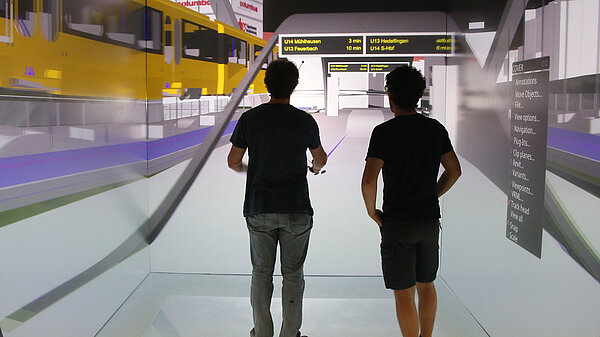High-Performance Computing Center Stuttgart

On June 20, 2023, researchers in the Visualization Department of the High-Performance Computing Center Stuttgart (HLRS) hosted a full-day hackathon aimed at developing new ideas for the Rosenstein Bridge. Held as a side event of the Urban Future 2023 conference, the hackathon invited city planners and others to HLRS to imagine the site’s possible future.
The event also took place as part of CapeReviso, a project that has been developing planning and decision support tools for analyzing and reducing conflicts between cyclists and pedestrians. CapeReviso is a collaboration among HLRS, the Karlsruhe Institute of Technology (KIT), and the Allgemeiner Deutscher Fahrrad-Club, and is funded by the German Federal Ministry of Digital and Transport.
“For several years now, HLRS has been developing methods that use high-performance computing, machine learning, and advanced visualization technologies to support city planning,” said Thomas Obst, a research scientist in the HLRS Visualization Department. “Especially with the tools developed in CapeReviso we can add significant context to virtual models, such as traffic simulations of a location, based on real observations. This helps to gain insights about potential conflicts among different road users in an early design stage. In the context of the Urban Future conference, we saw a chance to support efforts in Stuttgart to improve an important piece of infrastructure.”

Before the event, teams of students working with Dr. Peter Zeile, a senior researcher in KIT’s city planning program, developed seven concepts for a new Rosensteinbrücke. During the hackathon they presented their preliminary renderings, inviting comments and suggestions. Staff in HLRS’s Visualization Department then helped the young city planners to import their digital designs into HLRS’s CAVE visualization environment. Viewed in immersive virtual reality, the students could experience how their plans might look if built and discussed how they could be optimized. The visualizations were also integrated into HLRS’s digital twin of the city of Stuttgart, helping the students to better understand how the design concepts would fit into the surrounding neighborhoods and transportation networks.
The resulting proposals not only offered attractive solutions for the basic structure of the bridge, but also imagined how the relatively narrow space could simultaneously accommodate a variety of uses, including an U-Bahn station, bicycle lanes, and pedestrian traffic. Several proposals also offered tantalizing suggestions that reimagined the bridge’s function with respect to its surroundings. This included designating space for seating on the bridge, using vegetation to make it more attractive and environmentally sensitive, and integrating the bridge into other revitalization efforts along the Neckar waterfront.
A few days later, HLRS invited the Urban Future conference attendees to visit the center to review the design proposals in the CAVE as part of a field trip. The city planners gathered additional input that will support their preparations to present their concepts to city officials later this summer.

According to Dr. Zeile, the chance for his students to work in the CAVE offered a number of advantages. “The students already do 3D design on their desktops, but the opportunity to immerse themselves in their concepts in the CAVE enabled them to experience them in one-to-one scale,” he explained. “This gave them a better understanding of space within the city — for example, with respect to sightlines — and of how the use of vegetation or particular materials might function. Everyone agreed that it was a great tool to use during a design sprint.”
HLRS’s city development hackathon was held in coordination with Urban Future 2023, an annual, international conference for city planning experts, politicians, entrepreneurs, and others who are working to make cities more sustainable. Held in a different city every year, Stuttgart provided a suitable location for the 2023 conference due to ongoing, transformative building projects that are taking place around its new train station and elsewhere in the city. Stuttgart and the surrounding region will also be the focus of the Internationale Bauausstellung 2027 (IBA’27).
— Christopher Williams